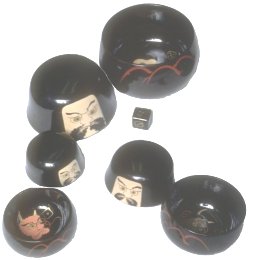
After dinner in China and Japan in 16th and 17th century, and perhaps earlier, games using equipment similar to the type pictured on the left were popular. To some degree, they still remain popular. The set in the photograph was made in Japan and purchased in New York City in the mid 1950's in an antique shop, and donated to the Museum in 1972.
The game pieces came in a square cardboard box covered with a mottled blue/gray/white paper. The box lid is 8.1cm square x 2.1cm high; the lid bottom is 7.8cm square x 8.7cm high.
There are 7 game pieces - 3 cups of different sizes with associated tops and one die. The die is a 1.3cm square single shiny black lacquered wooden die. The sides contain painted dots for numbers 1 through 5. The 6th side has 2 painted joined musical notes.
The cups measure: 1) 7.7cm diameter x 7.8cm high, 2) 6cm diameter x 5.8cm high, and 3) 4.9cm diameter x 4.4cm high. Cups/lids are black lacquered wood, hand painted with a stylized scowling face on the outside of each lid. There is a suggestion of a red robe or body on the outside bottom of each cup. On the inside of each cup bottom and lid there is different painted face along with dots which coincide with the side of the die. Each lid forms a smaller cup than its base, thus for purposes of the game there are 6 cups - each coinciding with one of the sides of the die. The lid of smallest cup has a musical note painted on the inside rather than dots. The cups and lids are graduated in size, so that when the die is placed in the smallest cup, the smallest cup/lid fits into the middle cup/lid. Then the middle sized cup fits into the largest cup enabling storage of the set in the square box.
A viewer of this Website donated the orange colored set (on the right) which they indicated had belonged to a sailor who acquired this orange set while serving in the Pacific during World War II.
No instructions for playing the game were provided with either set; however, this is a traditional game, and in speaking with several older Japanese people about the game, and reading descriptions of life a few hundred years ago in China and Japan, the following playing instructions have been developed and tested. Note: alternative everyday kitchenware was used for testing (such as ramekins and custard cups)!
So here is one way to play this game :
Any number of players at the dinner table can play, but a minimum of 6 players seems best. After dinner is finished and the table is cleared, the set is placed on the table. The host fills each of the six cups with a different beverage (or the same beverage) such as an after dinner drink - brandy, B&B, Kuhala, Amaretto, Grand Marnier, Baileys, etc.
The person to the right of the host rolls the die first. Dependent upon which face of the dice is on top when it lands, that player must do the task corresponding to that number (see below). The task must be completed to the satisfaction of the other guests. If the task is completed successfully, play passes to the next person to the right. If the task is not completed successfully (to the satisfaction of the other guests), the player must drink the contents of the corresponding cup. Play continues around to the right.
The Tasks
Offer an interesting FACT to the guests
Pose a RIDDLE to the guests (and stump them)
Tell a JOKE that makes all the guests laugh
PANTOMIME a famous saying (so one of the quests guesses what it is)
Make up a POEM (traditionally a Haiku) or LIMERICK on the spot
Musical Note. Sing a SONG
Note: as the game progresses, and guests are not satisfied, it becomes harder for a player to complete a task!
(It has been suggested that to modify the game for the use of children, dried fruit, nuts, and various candies may be used in the cups instead of after dinner drinks!)
Last update March 24, 2010